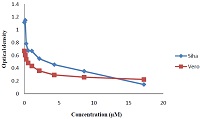Effect of vesicular encapsulation on in-vitro cytotoxicity of ciclopirox olamine
Keywords:
liposome, niosome, anticancer, ciclopirox olamine,, cytotoxicityAbstract
Ciclopirox olamine (CPO), an antifungal has recently been cited as a drug repurposed for cancer treatment. Vesicular drug delivery systems like liposomes and niosomes have proven to increase the efficacy of anticancer drugs. The purpose of this paper was to evaluate the effect of two vesicular delivery systems liposome and niosome on the anticancer potential of CPO using in vitro cytotoxicity assays. CPO was encapsulated in liposomes (prepared from Phospholipon®90H) and niosomes (prepared from Span 60) by ethanol injection method. The cytotoxic effect of liposomal and niosomal CPO was evaluated on KB (oral cancer), PC3 (prostate cancer), Siha (cervical cancer) and Vero (kidney epithelial) cell lines using MTT assay. The IC50 values were compared with free drug CPO and with standard anticancer drug doxorubicin. CPO exhibited cytotoxicity to all the cell lines studied. The niosomal encapsulation of CPO favored its cytotoxicity on the cancer cell lines. Much lower IC50 values were obtained in comparison to the liposomal and free form of CPO. The enhancement in the cytotoxic effect on the non-cancer cell line Vero was not noted. CPO demonstrated marginal difference in the concentration required to produce cytotoxic effect on cancer and normal cell lines. The difference was enhanced by niosomal CPO as much lower concentration was required to produce cytotoxic effect on cancer cells while rendering no effect on normal cells. Enhanced cytotoxicity selectively to cancer cells in the present study demonstrates the pharmacological significance of niosomal drug delivery system of CPO.
References
Obadiah J, Scher R. Nail disorders: unapproved treatments. Clin Dermatol. 2002;20: 643-648.
Gupta AK, Bluhm R. Ciclopirox (Loprox) gel for superficial fungal infections. Skin Therapy Lett. 2004;9 (7): 4-5.
Almeida B, Sampaio-Marques B, Carvalho J, Silva MT, Leao C, Rodrigues F, Ludovico P. An atypical active cell death process underlies the fungicidal activity of ciclopirox olamine against the yeast Saccharomyces cerevisiae. FEMS Yeast Res. 2007;7: 404–412.
Eberhard Y, McDermott SP, Wang X, Gronda M, Venugopal A, Wood TE, Hurren R, Datti A, Batey RA, Wrana J, Antholine WE, Dick JE, Schimmer AD. Chelation of intracellular iron with the antifungal agent ciclopirox olamine induces cell death in leukemia and myeloma cells. Blood. 2009;114(14):3064-3073.
Vazquez-Martina A, López-Bonet E, Cufía S, Oliveras-Ferrarosa C, DelBarcob S, Martin-Castillob B, Menendez JA. Repositioning chloroquine and metformin to eliminate cancer stem cell traits in pre-malignant lesions. Drug Resist Update. 2011; 14(4): 212-213.
Swamidass SJ. Mining small-molecule screens to repurpose drugs. Brief Bioinform. 2011;12(4): 327-335.
Roy A, Volgin DV, Baby SM, Mokashi A, Kubin L, Lahiri S. Activation of HIF-1α mRNA by hypoxia and iron chelator in isolated rat carotid body. Neurosci Lett. 2004;363(3): 229-232.
Snyder RD, Ewing D, Hendry LB. DNA intercalative potential of marketed drugs testing positive in in vitro cytogenetic assays. Mutat Res–Genetic Toxicol Environ Mutagen. 2006;609(1):47-59.
Malam Y, Loizidou M, Seifalian AM. Liposomes and nanoparticles: nanosized vehicles for drug delivery in cancer. Trends Pharmacol Sci. 2009;30(11):592-9.
Gregoriadis G. Targeting of drugs: implications in medicine. Lancet.1981;2(8240): 241-246.
Zamboni WC. Liposomal, nanoparticle, and conjugated formulations of anticancer agents. 2005;Clin Cancer Res 11:8230-8234.
Torchilin VP. Recent advances with liposomes as pharmaceutical carriers. Nat Rev Drug Discov.2005;4(2):145-160.
Uchegbu IF, Double JA, Turton JA, Florence AT. Distribution, metabolism and tumoricidal activity of doxorubicin administered in sorbitan monostearate (Span 60) niosomes in the mouse. Pharm Res.1995;12(7):1019-24.
Uchegbu I, Jeoma F, Florence A. Nonionic surfactant vesicles (niosomes): physical and pharmaceutical chemistry. Adv Coll Int Sci. 1996; 58:1–55.
Chandraprakash KS, Udupa N, Umadevi P, Pillai GK. Formulation and evaluation of methotrexate niosomes. Indian J Pharm Sci.1992;54(5):197.
Cable C: An examination of the effects of surface modifications on the physicochemical and biological properties of non-ionic surfactant vesicles.PhD thesis.Glasgow: University of Strathclyde;1989
Bragagnia M, Menninia N, Ghelardinib C, Mura P. Development and characterization of niosomal formulations of doxorubicin aimed at brain targeting. J Pharm Pharmaceut Sci. 2012;15(1):184 – 196.
Parthasarathi G, Udupa N, Pillai GK. Formulation and in vitro evaluation of vincristine encapsulated niosomes. Indian J Pharm Sci. 1994;56(3):90-94.
Paolino D, Cosco D, Muzzalupo R, Trapasso E, Picci N, Fresta M. Innovative bola-surfactant niosomes as topical delivery systems of 5-fluorouracil for the treatment of skin cancer. Int. J. Pharm. 2008;353:1-2, 233-242.
Shaikh KS and Pawar AP. Liposomal delivery enhances cutaneous availability of ciclopirox olamine. Lat Am J Pharm. 2010;29(5):763-70.
Shaikh KS, Bothiraja C, Pawar AP. Studies on non-ionic surfactant bilayer vesicles of ciclopirox olamine. Drug Dev Ind Pharm. 2010;6:946-953.
Arpornsuwan T and Punjanon T. Tumor cell selective antiproliferative effect of the extract from Morinda citrifolia fruits. Phytother Res. 2006;20(6):515-517.
Prasanna R, Harish CC, Pichai R, Sakthisekaran D, Gunasekaran P. Anticancer effect of Cassia auriculata leaf extract in vitro through cell cycle arrest and induction of apoptosis in human breast and larynx cancer cell lines. Cell Biol Int . 2009;33(2):127-134.
Alvi IA, Madan JJ, Kaushik DD, Sardana SS, Pandey RS, Ali A. Comparative study of transfersomes, liposomes, and niosomes for topical delivery of 5-fluorouracil to skin cancer cells: preparation, characterization, in-vitro release, and cytotoxicity analysis. Anti-Cancer Drugs. 2011;22 (8):774–782.
Lee KD, Hong K, Papahadjopoulos D. Recognition of liposomes by cells: in vitro binding and endocytosis mediated by specific lipid headgroups and surface charge density. Biochim Biophys Acta. 1992;1103(2):185-97.
Krasnici S, Werner A, Eichhorn ME, Schmitt-Sody M, Pahernik SA, Sauer B, Schulze B, Teifel M, Michaelis U, Naujoks K, Dellian M. Effect of the surface charge of liposomes on their uptake by angiogenic tumor vessels. Int J Cancer. 2003;105(4): 561-567.
Drummond D, Meyer O, Hong K, Kirpotin D, Papahadjopoulos D.. Optimizing liposomes for delivery of chemotherapeutic agents to solid tumors. Pharmacol Rev. 2004; 51(4): 691-743.





